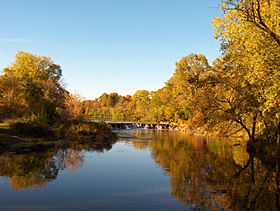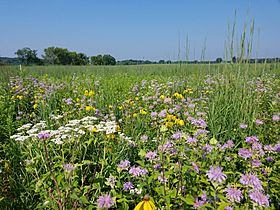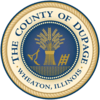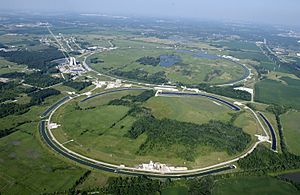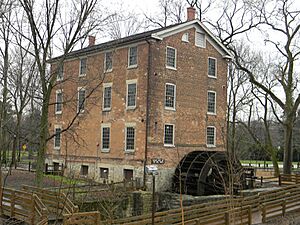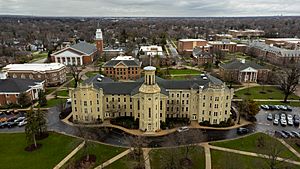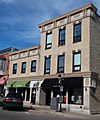DuPage County, Illinois facts for kids
Quick facts for kids
DuPage County
|
||
|---|---|---|
|
County
|
||
|
Warrenville Grove Forest Preserve on the West Branch of the DuPage River; Restored tallgrass prairie in Dunham Forest Preserve
|
||
|
||
| Motto(s):
The Magnificent Miles West of Chicago
|
||
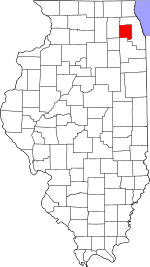
Location within the U.S. state of Illinois
|
||
 Illinois's location within the U.S. |
||
| Country | ||
| State | ||
| Founded | February 9, 1839 | |
| Named for | DuPage River | |
| Seat | Wheaton | |
| Largest city | Aurora | |
| Area | ||
| • Total | 336 sq mi (870 km2) | |
| • Land | 327 sq mi (850 km2) | |
| • Water | 8.9 sq mi (23 km2) 2.6% | |
| Population
(2020)
|
||
| • Total | 932,877 |
|
| • Density | 2,800/sq mi (1,100/km2) | |
| Time zone | UTC−6 (Central) | |
| • Summer (DST) | UTC−5 (CDT) | |
| Area code | 630 and 331 | |
| Congressional districts | 3rd, 4th, 6th, 8th, 11th | |
DuPage County is a county in Illinois, a state in the United States. It's one of the "collar counties" around the big city of Chicago. In 2020, about 932,877 people lived here, making it the second-most populated county in Illinois. The main town where the county government is located is Wheaton.
DuPage County used to have huge tallgrass prairies. Now, it's mostly developed with towns and suburbs. But you can still find some farms in the western and northern parts. The county is known for being home to the main offices of many large companies because it's so close to Chicago. Many people who live in towns like Hinsdale, Naperville, and Oak Brook are among the wealthiest in the Midwest. Overall, families in DuPage County tend to earn good incomes, and not many people live in poverty compared to the rest of the country.
Contents
History of DuPage County
Before European settlers arrived, the land that is now DuPage County was home to the Potawatomi people. By 1800, they had four main villages along the rivers and many trails crossing the area.
The first European-American settlers came to DuPage County in 1832. Just one year later, the Potawatomi people had to leave the area after signing the Treaty of Chicago. DuPage County was officially created on February 9, 1839. It was formed from a part of Cook County.
The county got its name from the DuPage River. The river itself was named after a French fur trapper named DuPage, who lived there before 1800. People who wrote about the county's history say that the river was well-known by this name even back then.
The first white settler in DuPage County was Bailey Hobson. In 1831, he and Lewis Stewart built a house for the Hobson family. This house was about 2 miles south of where downtown Naperville is today. Bailey Hobson later built a mill to help local farmers. You can still see the Hobson house on Hobson Road in Naperville. A monument with a millstone in Pioneer Park marks where the mill used to be.
Geography and Climate
DuPage County covers about 336 square miles. Most of this (327 square miles) is land, and a small part (8.9 square miles) is water. The DuPage River and the Salt Creek both flow through the county. The highest point in DuPage County is at the Mallard Lake Landfill, which is about 982 feet above sea level.
Weather in DuPage County
The weather in DuPage County changes a lot with the seasons. In the county seat of Wheaton, average temperatures are around 14°F in January (the coldest month) and 87°F in July (the warmest month). However, it can get much colder or hotter! The record low was -26°F in January 1985, and the record high was 105°F in July 1995. The county gets between 1.56 inches of rain in February and 4.60 inches in August.
Neighboring Counties
DuPage County shares borders with these other counties:
- Cook County (to the east and north)
- Will County (to the south)
- Kendall County (to the southwest, they meet at a corner)
- Kane County (to the west)
People of DuPage County
DuPage County has grown a lot over the years. In 1840, there were only 3,535 people. By 2020, the population had grown to 932,877!
The county is becoming more and more diverse. In 2020, about 63% of the people were White, 4.7% Black, 12.7% Asian, and 15.4% were Hispanic or Latino (who can be of any race).
Many people in DuPage County have German, Irish, Polish, Italian, and English backgrounds. The largest Hispanic group is Mexican Americans. Among Asian groups, many people are from India, the Philippines, China, and Pakistan.
DuPage County is also home to many people who were born in other countries. In 2022, about 20% of residents were born abroad. Most of them came from Asia (45.2%) and Latin America (25.8%). The top countries where immigrants in DuPage County were born are Mexico, India, Poland, the Philippines, and China.
Families in DuPage County generally have good incomes. In 2022, the average income per person was $88,588, which was one of the highest in Illinois. The poverty rate in DuPage County is low, at 6.7%. This means that most people have enough money to live comfortably.
Religions in DuPage County
DuPage County has many different places of worship. There are hundreds of Christian churches, especially around Wheaton. Wheaton College is a well-known Christian college there. There's also a large Catholic community, and the National Shrine of St Therese is in Darien.
You can also find other religions here. The Theosophical Society in America in Wheaton offers classes on different spiritual ideas like meditation and yoga. There are many Islamic mosques in towns like Villa Park and Naperville. Hindu temples are located in Bartlett, Bensenville, and other towns. There are also Buddhist temples and Jewish synagogues in the county.
Economy and Jobs
DuPage County is a major center for technology and research in Illinois. Many large companies have their main offices here. Some of these include:
- Ace Hardware (Oak Brook)
- BP (Warrenville)
- Dover Corporation (Downers Grove)
- Navistar International (Lisle)
- OfficeMax (Naperville)
- Sara Lee Corporation (Downers Grove)
The county also has several large shopping malls, like Oakbrook Center, which is one of the biggest outdoor malls in the country. Many towns in DuPage County, like Naperville and Glen Ellyn, have charming downtown areas with unique shops and restaurants.
Science and Research Centers
Fermilab is a very important science lab located on the border of Kane and DuPage counties. It has one of the world's most powerful particle accelerators, which scientists use to study tiny particles.
Argonne National Laboratory is another big science and engineering research lab in DuPage County. It's one of the oldest and largest labs run by the U.S. government. Both Fermilab and Argonne offer tours so people can see what they do.
Arts and Culture
Cool Buildings and Art
The Oakbrook Terrace Tower in Oakbrook Terrace is 31 stories tall. It's the tallest building in Illinois outside of Chicago! The Elmhurst Art Museum is in a building designed by a famous architect named Ludwig Mies van der Rohe. There's even a house designed by the famous architect Frank Lloyd Wright in Elmhurst.
In Bartlett, there's a large, beautiful Hindu temple called BAPS Shri Swaminarayan Mandir Chicago. It's made of intricately carved marble. You can also find unique Lustron homes, which are prefabricated steel houses, in Lombard.
Museums and Historic Places
DuPage County has many museums where you can learn about history and art:
- Cantigny Park and First Division Museum in Wheaton, on the old estate of a newspaper owner.
- DuPage County Historical Museum in Wheaton.
- Graue Mill in Oak Brook, an old mill you can visit.
- Naper Settlement in Naperville, a living history museum that shows what life was like in the past.
- The DuPage Children's Museum in Naperville, which is great for younger kids.
- The Elmhurst Art Museum, which includes the McCormick House by Mies Van Der Rohe.
- The Billy Graham Center and Marion E. Wade Center at Wheaton College.
Some important historical sites include:
- Joe Naper's General Store in Naperville.
- Pioneer Park in Naperville, which honors the first settlers.
- Stacy's Tavern in Glen Ellyn, an old inn.
Music and Theater
DuPage County has a lively music scene. Some well-known bands like The Hush Sound and Plain White T's started here.
If you like live shows, the Drury Lane Theatre in Oakbrook Terrace is a popular spot. The Tivoli Theatre in Downers Grove is one of the first theaters in the U.S. to have sound for movies, and it's still used today for movies and local performances. The McAninch Arts Center at the College of DuPage also hosts many music, dance, and theater shows.
Parks and Outdoor Fun
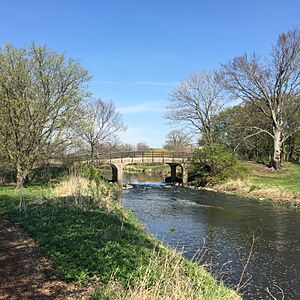
The Forest Preserve District of DuPage County takes care of over 25,000 acres of prairies, woodlands, and wetlands. It's a great place to explore nature! There are 60 forest preserves, 145 miles of trails for walking and biking, and five education centers. Over 4 million people visit these preserves each year.
Other fun places to visit include:
- Lilacia Park in Lombard, known for its beautiful flowers.
- Centennial Beach in Naperville, a popular swimming spot.
- Cosley Zoo in Wheaton, a small zoo with animals.
- Morton Arboretum in Lisle, a huge outdoor museum of trees and plants.
The Illinois Prairie Path is a 61-mile long trail that used to be a railroad line. It's perfect for walking, running, and biking, and it goes through DuPage, Cook, and Kane Counties. It connects with other trails too, like the Great Western Trail.
DuPage County also has many golf courses, including famous ones like Chicago Golf Club and Medinah Country Club.
Education
Colleges and Universities
DuPage County has several colleges and universities:
- College of DuPage in Glen Ellyn is one of the largest community colleges in the United States.
- Wheaton College is a very well-known Christian college.
- Benedictine University, Elmhurst University, and North Central College also have long histories in their communities.
- Other colleges include Midwestern University in Downers Grove, National University of Health Sciences in Lombard, and campuses for DeVry University and Northern Illinois University.
Schools in DuPage County
The DuPage County Regional Office of Education helps oversee the public schools in the county. There are 42 school districts that serve over 161,000 students in 245 schools.
There are many public high schools in DuPage County, such as:
- Addison Trail High School
- Downers Grove North High School
- Glenbard East High School
- Hinsdale Central High School
- Naperville North High School
- Wheaton North High School
- York Community High School
The county also has several private high schools, including:
- Benet Academy
- IC Catholic Prep
- Montini Catholic High School
- St. Francis High School
- Wheaton Academy
Getting Around DuPage County
Transportation
DuPage County has good transportation options. Besides a part of O'Hare International Airport, there are also smaller airports like DuPage Airport.
You can get around using the Pace bus system. For longer trips, Metra, Chicago's commuter train system, has three lines that go through DuPage County, with 19 stations. Amtrak also stops at the Naperville station, connecting the county to cities like Chicago, Los Angeles, and San Francisco.
Major Roads
DuPage County has many important highways, including five Interstate Highways (like I-55, I-88, I-290, I-294, I-355), three U.S. Highways (like US 20, US 34), and nine Illinois Routes. Historic U.S. Route 66 also passes through the southeastern part of the county.
Walking and Biking Trails
Besides the Illinois Prairie Path, there are other great trails for walking and biking:
- Great Western Trail
- Salt Creek Trail
- Southern DuPage County Regional Trail
Communities in DuPage County
Cities
- Aurora (part)
- Batavia (part)
- Darien
- Elmhurst
- Naperville
- Oakbrook Terrace
- Warrenville
- West Chicago
- Wheaton
- Wood Dale
Villages
- Addison
- Bartlett (mostly)
- Bloomingdale
- Carol Stream
- Clarendon Hills
- Downers Grove
- Glendale Heights
- Glen Ellyn
- Hinsdale (mostly)
- Itasca
- Lisle
- Lombard
- Oak Brook (mostly)
- Roselle (mostly)
- Villa Park
- Westmont
- Willowbrook
- Winfield
- Woodridge (mostly)
Unincorporated Areas
These are areas that are not part of any city or village:
- Belmont
- Butterfield
- Medinah
- York Center
Townships
DuPage County is divided into nine townships, which are local government areas:
- Downers Grove Township
- York Township
- Milton Township
- Lisle Township
- Bloomingdale Township
- Naperville Township
- Addison Township
- Wayne Township
- Winfield Township
Images for kids
See also
 In Spanish: Condado de DuPage para niños
In Spanish: Condado de DuPage para niños


